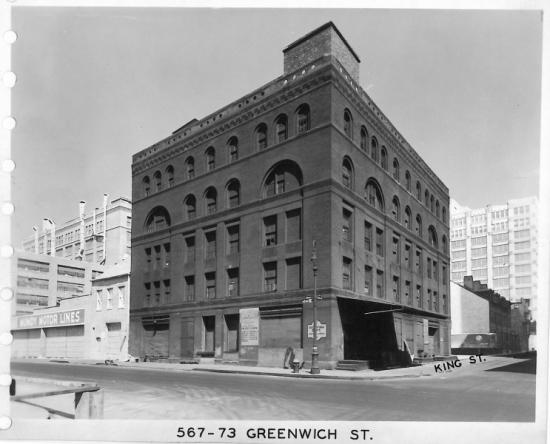How the Triangle Shirtwaist Factory Fire Changed Trinity
The rebuilt 567-573 Greenwich Street building.
March 25, 2011, marks the 100th anniversary of Triangle Shirtwaist Factory fire. The fire, which broke out in an 8th floor garment factory near Washington Square Park, killed 146 workers, most of them teenage immigrant girls, largely because of lax workplace safety standards. One of the two exits to the factory was locked, ostensibly to prevent workers from stealing fabric scraps, and the building’s only fire escape collapsed under the weight of fleeing workers. Firemen’s ladders only reached the building’s sixth floor.
The fire was a turning point in the American labor and progressive movements. For the first time, public opinion favored government regulation of workplaces. The New York State Assembly and New York State Department of Labor quickly enacted laws regulating the safety of the workplace, child labor, and fire prevention, including installation of sprinkler systems and exit signs.
Vestry minutes from 1911 and 1912 show that Trinity acted quickly to comply with the new rules. On May 8, 1911, the vestry made provision for the installation of sprinkler systems and fire escapes on Trinity-owned buildings. In 1913, the parish hired its first fire safety direct, Frederick A. Ross. Ross was charged with conducting fire drills in the Parish School and supervising fire apparatus in the churches and school buildings.
But Trinity’s most interesting connection to the Triangle Shirtwaist Factory fire actually occurred in 1905. A fire broke out in Frederick Neff’s paper box factory at 567 Greenwich Street—a Trinity building--on November 3 of that year. Workplace fires were common at the time: a fire at a nearby Christmas card factory was reported in the same article.
Trinity built 567-573 Greenwich Street, located at the northeast corner of King and Greenwich Streets, in 1881 and 1882, before the advent of fire safety legislation. The 1905 fire could have been disastrous, but the building was equipped with fire escapes, which held up under the stress of the fire, and firemen’s ladders reached the building’s highest floors. No one was killed.
“The blaze started in the ground floor of Frederick’s Neff’s factory. There were about 150 girls in the building at the time. Roundsman Waldron of the Macdougal Street Station turned in an alarm and hastened back to the factory, where he found a crowd of girls screaming hysterically on the King Street side. The flames, feeding upon the paper stored in the basement, had cut off the exits to the street. The girls had to be carried in pairs to safety. Many of them fainted.
Lieut. Ricketts of Engine 30, with Firemen Cody and Condon, raised a ladder to the second floor, from which a number of girls had been taken. Just as the last was handed to the ground the floor of the second story fell in, and the flames from the blazing paper burst through the windows.”
The building was destroyed in the blaze and had to be rebuilt. Mr. Neff and his paper box factory became tenants in the new building.






